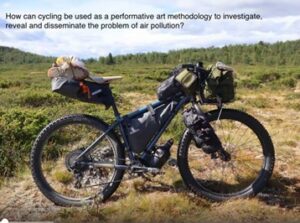‘I think it’s valuable for students to see that their design work can make a difference or resonate with people’
Clare Nattress, lecturer in Graphic Design, discusses activism in design and her own air pollution research.

Learn more about Clare Nattress’ research here.
Clare Nattress is a lecturer in Graphic Design who, along with her colleague Andrew Byrom, is embedding the Living Lab into the brief of the Year 1 Specialist Projects Module. Nattress’ activism and interest in air pollution is encompassed in her own study too, as her PhD research delves into cycling as a ‘performative art methodology to investigate […] air pollution’. With the help of Dr Adam Odell and scientists at York University, her collated data is being analysed for their implications on human health.
‘Activism and environmental issues are considered in design and students have, in recent years especially, become more aware of sustainability, environmental, global, and political issues’, Nattress tells me. The Specialist Projects brief, she says, encourages students to work effectively as ‘an individual, with others, and to develop knowledge and understanding of emerging technologies and practices in both interdisciplinary and specialist project contexts.’ This Living Lab brief means that students are actively working alongside other modules— which encourages new and exciting forms of collaboration and communication. When I ask about the initial student responses, Nattress replies that she hoped the students would ‘find the brief interesting, engaging as well as thought provoking’. She tells me that students were intrigued when they got ‘to know the other nine courses who are responding to the brief and what else was being created.’ In sessions, the class have been discussing the health problems and concerns of those living at the corner of Gillygate and Lord Mayor’s Walk, and what biodiversity can be found at the junction.
For their Specialist Project, students will be exploring and ‘experiment[ing] with design principles in order to communicate ideas and information in appropriate forms.’ Nattress explains that these are ‘working situations’, where students engage their social and technical skills to produce work for the public to see. ‘No doubt [it will] be nerve racking for them,’ she says, ‘but building confidence in their own work is key.’ I’m excited to see how the students will engage with this idea and to see what final projects result from this brief. As we’ve seen from the Institute for Social Justice Student Prize design activists, such as Alissa Morgan, can impact large audiences and engage meaningfully with many socio-political ideas. ‘I think it’s valuable for students to see that their design work can make a difference or resonate with people’, Nattress tells me, ‘we thought the Living Lab would be a healthy challenge to end their first year of study.’
Nattress reports that her own studies are producing fascinating results. Over the past few months, she has been collecting ambient air pollution whilst cycling. The filter papers that the pollution is collected on are being analysed by Dr Adam Odell and by scientists at the Wolfson Atmospheric Chemistry Laboratories at York University. She says that her work with Odell, which explores the effects of air quality on human health, found evidence of a link between reduced air quality and the growth of leukaemia cells. Nattress explains that to test the ‘impact of trapped particulates collected on filters firstly requires solubilising or extracting any chemicals, nanoparticles or larger particulate matter from each filter.’ The filters were divided into quarters and then incubated with 0.5ml of the chosen solvent, dimethylsulfoxide (DMSO). From here, soluble materials were collected through centrifugation— a powerful mechanism which quickly rotates samples and aids separation— before adding ‘various cancer and immortalised cell lines.’ The two used the NB4 cell line, which is a ‘model for acute promyelocytic leukaemia.’ Nattress goes on to say that ‘by diluting the solubilised filter material in cell growth media we treated cells for 3-6 days using a dilution range between 1:5000 and 1:200. Cell growth and survival was assessed by adding a chemical compound that changes colour in the presence of viable healthy cells.’ As a result, they have ‘discovered that filters gathered from Delhi and one from around York were able to selectively increase the growth of the leukaemia cells only after 5-6 days treatment, hinting at a carcinogenic, pro-cancer effect’. It is an incredible discovery with far-reaching impacts on those who interact with the junction, and one which will help to build a powerful case for imminent change.